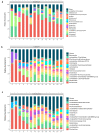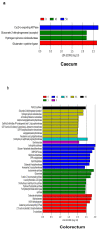Microbial Diversity and Community Variation in the Intestines of Layer Chickens
- PMID: 33809729
- PMCID: PMC8002243
- DOI: 10.3390/ani11030840
Microbial Diversity and Community Variation in the Intestines of Layer Chickens
Abstract
The intestinal microbiota is increasingly recognized as an important component of host health, metabolism and immunity. Early gut colonizers are pivotal in the establishment of microbial community structures affecting the health and growth performance of chickens. White Lohmann layer is a common commercial breed. Therefore, this breed was selected to study the pattern of changes of microbiota with age. In this study, the duodenum, caecum and colorectum contents of white Lohmann layer chickens from same environment control farm were collected and analyzed using 16S rRNA sequencing to explore the spatial and temporal variations in intestinal microbiota. The results showed that the diversity of the microbial community structure in the duodenum, caecum and colorectum increased with age and tended to be stable when the layer chickens reached 50 days of age and the distinct succession patterns of the intestinal microbiota between the duodenum and large intestine (caecum and colorectum). On day 0, the diversity of microbes in the duodenum was higher than that in the caecum and colorectum, but the compositions of intestinal microbes were relatively similar, with facultative anaerobic Proteobacteria as the main microbes. However, the relative abundance of facultative anaerobic bacteria (Escherichia) gradually decreased and was replaced by anaerobic bacteria (Bacteroides and Ruminococcaceae). By day 50, the structure of intestinal microbes had gradually become stable, and Lactobacillus was the dominant bacteria in the duodenum (41.1%). The compositions of dominant microbes in the caecum and colorectum were more complex, but there were certain similarities. Bacteroides, Odoribacter and Clostridiales vadin BB60 group were dominant. The results of this study provide evidence that time and spatial factors are important factors affecting the intestinal microbiota composition. This study provides new knowledge of the intestinal microbiota colonization pattern of layer chickens in early life to improve the intestinal health of layer chickens.
Keywords: 16S rRNA; diversity and community; intestinal microbiome; white Lohmann layer chickens.
Conflict of interest statement
The authors declare no conflict of interest.
Figures







Similar articles
-
Analysis of the Microbial Intestinal Tract in Broiler Chickens during the Rearing Period.Biology (Basel). 2021 Sep 21;10(9):942. doi: 10.3390/biology10090942. Biology (Basel). 2021. PMID: 34571819 Free PMC article.
-
The Spatial and Temporal Characterization of Gut Microbiota in Broilers.Front Vet Sci. 2021 Aug 30;8:712226. doi: 10.3389/fvets.2021.712226. eCollection 2021. Front Vet Sci. 2021. PMID: 34527716 Free PMC article.
-
Microbial community mapping in intestinal tract of broiler chicken.Poult Sci. 2017 May 1;96(5):1387-1393. doi: 10.3382/ps/pew372. Poult Sci. 2017. PMID: 28339527
-
Host and Environmental Factors Affecting the Intestinal Microbiota in Chickens.Front Microbiol. 2018 Feb 16;9:235. doi: 10.3389/fmicb.2018.00235. eCollection 2018. Front Microbiol. 2018. PMID: 29503637 Free PMC article. Review.
-
Piglet gut microbial shifts early in life: causes and effects.J Anim Sci Biotechnol. 2019 Jan 14;10:1. doi: 10.1186/s40104-018-0308-3. eCollection 2019. J Anim Sci Biotechnol. 2019. PMID: 30651985 Free PMC article. Review.
Cited by
-
Dietary supplementation with Epimedium contributes to the improvement of hormone levels, gut microbiota, and serum metabolite composition in the Chinese forest musk deer (Moschus berezovskii).Front Vet Sci. 2025 Jan 22;11:1497115. doi: 10.3389/fvets.2024.1497115. eCollection 2024. Front Vet Sci. 2025. PMID: 39911481 Free PMC article.
-
Comparison of Cecal Microbiota and Performance Indices Between Lean-Type and Fatty-Type Pekin Ducks.Front Microbiol. 2022 Mar 8;13:820569. doi: 10.3389/fmicb.2022.820569. eCollection 2022. Front Microbiol. 2022. PMID: 35350611 Free PMC article.
-
The abundance and diversity of antibiotic resistance genes in layer chicken ceca is associated with farm enviroment.Front Microbiol. 2023 Jun 30;14:1177404. doi: 10.3389/fmicb.2023.1177404. eCollection 2023. Front Microbiol. 2023. PMID: 37455745 Free PMC article.
-
The combined supplementation of quercetin and Ligilactobacillus salivarius improves production performance, lipid metabolism, and ileal health in late-phase laying hens.Poult Sci. 2025 Aug;104(8):105286. doi: 10.1016/j.psj.2025.105286. Epub 2025 May 10. Poult Sci. 2025. PMID: 40398296 Free PMC article.
-
Temporal stability and community assembly mechanisms in healthy broiler cecum.Front Microbiol. 2023 Sep 13;14:1197838. doi: 10.3389/fmicb.2023.1197838. eCollection 2023. Front Microbiol. 2023. PMID: 37779716 Free PMC article.
References
LinkOut - more resources
Full Text Sources
Other Literature Sources

